Smart City Policies
What makes a city “smart” beyond the technological level? The specifier “smart” has to carry a heavy load of requirements as it signifies a state of enabling positive and technologically innovative urban development while simultaneously preserving and fostering social and environmental sustainability. Engaging in the debate on which characteristics define a smart city and which role policies play, the second event of the Morgenstadt Global Smart Cities Initiative (MGI) webinar series was held on March 26, 2021. The session was introduced and moderated by Sophie Mok from the Fraunhofer IAO, who is responsible for the field of Climate Resilience and Capacity Building within MGI.
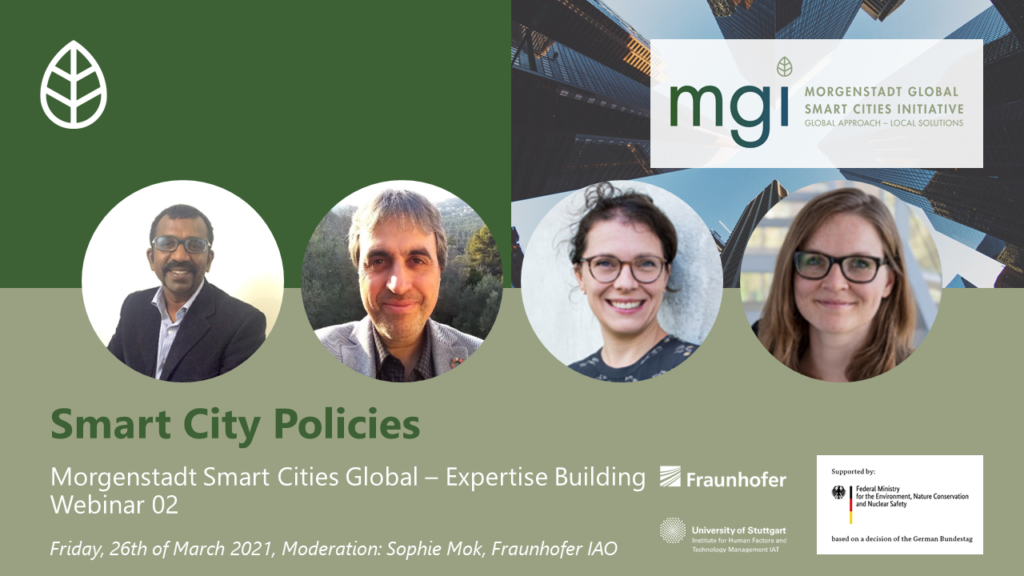
The objective of the webinar was to bring together international experts on the topic with a diverse range of actors from administration as well as academia and economy to enable an exchange on utilizing smart city innovations to reduce the environmental footprint of cities while at the same time increasing their resilience. More specifically, approaches, tools and best practices were presented and discussed revolving around the question of how to issue locally tailored regulations and incentives in the light of innovative technologies and their impact on urban development. Special consideration was taken on the ways in which multiple governance and organizational issues relate to addressing policy and decision making.
Smart City Policies. What For?
The first contribution was made by Josep Canals-Molina, who shared from his wide array of experiences as a strategic advisor in urban and environmental policies. In his presentation on the purpose of smart city policies, he stressed the importance of a holistic, ecological vision for the transformation of cities that includes various perspectives and builds on courage and imagination. Rather than being “smart” he regards the requirement for cities to be “clever” as in more suitable, exhibiting the capacity to adapt to a continually changing reality over an extended period of time.

A central aspect thereby is the public space as it encompasses all smart city sectors and provides the opportunity for manifesting democratic values. Technology is not seen as an end but a means, it has to be employed to find nature-based solutions to achieve the goal of a livable and resource efficient city. This point was illustrated by many examples among others from the Catalonian city Sabadell, where, by cutting of transit and refurbishing unused spaces, new multi-use spaces for the public were created to account for the fact that cars on average make up only about 20% of urban mobility. Infrastructures should reflect this circumstance by providing more space to the main modes of mobility like public transport, walking and cycling.
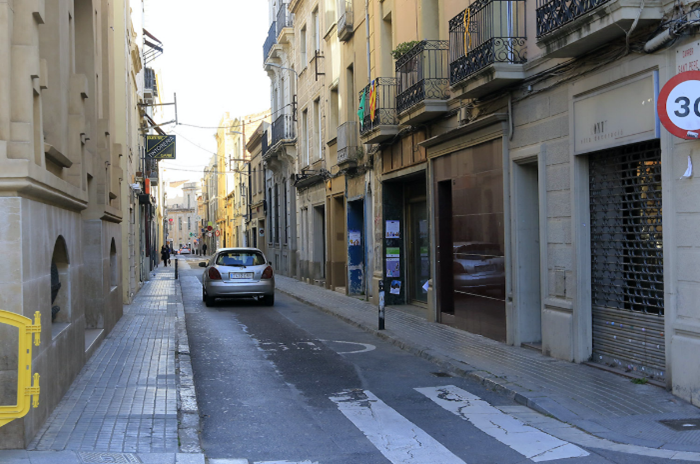
With all the possibilities afforded by modern information and communication technologies, one crucial function of smart city policies is to organize and direct the usage of these resources towards citizen participation, stakeholder involvement and sustainable urban planning.
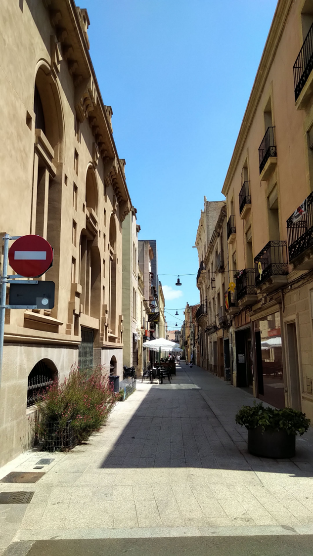
ClimateSMART Cities Assessment Framework
The second presentation was held by Dr. Umamaheshwaran Rajasekar, Head of the Climate Centre for Cities (C-Cube) and Chair Urban Resilience at the National Institute of Urban Affairs (NIUA). He took up on Josep Canals-Molina’s notion of a “clever” city and expanded the concept towards a “wise” city which takes a long-term planning approach and sees all aspects of urban life through a climate lens.
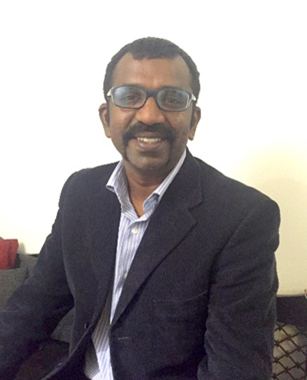
To address the rapidly evolving urbanization in India the Ministry of Housing and Urban Affairs initiated the ClimateSmart Cities Assessment Framework in 2019 to incentivize a holistic, climate responsive development in the 100 Smart Cities within the Smart City Mission. He introduced the framework which encompasses 28 indicators across 5 sectors and comprehends climate action as integrated in every aspect of the urban system. The indicators across the 5 sectors Urban Planning, Green Cover and Biodiversity, Energy and Green Buildings, Mobility and Air Quality, Water Management and Waste Management, allow cities to assess their current state as well as access funds, partners and technologies for taking the respective actions to increase climate resilience. Via knowledge exchange platforms the cities are enabled to find synergies, develop collaborative initiatives and share experiences and best practices to eventually scale up transformative actions. The ClimateSmart Cities Alliance consists of over 50 partners supporting in the development of strategic partnerships, providing a rich set of information and resources for implementation with the goal of mainstreaming climate resilience in India’s urban discourse.
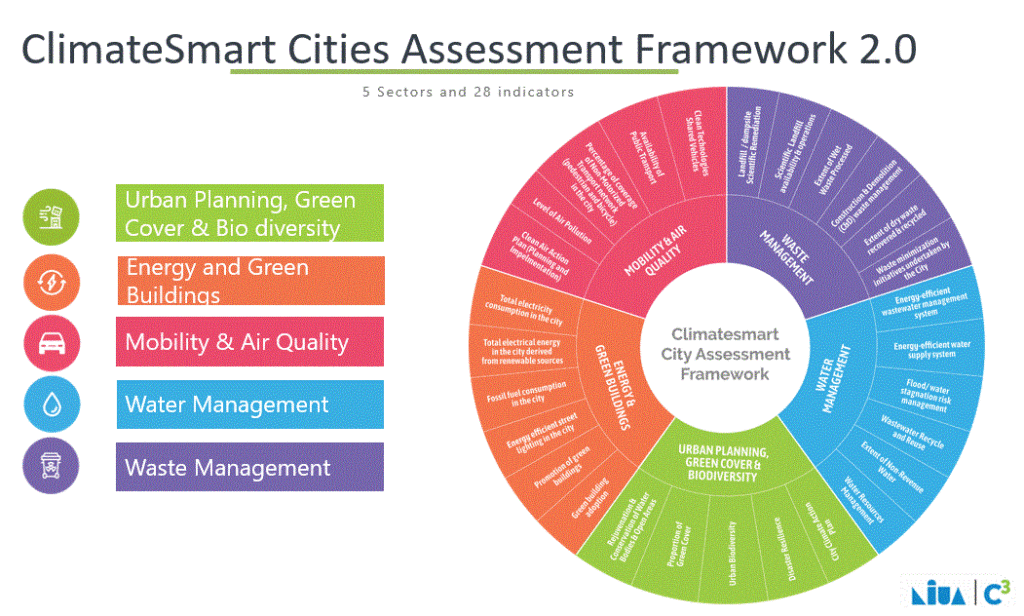
The integration of climate action into smart city policies on a holistic city level perspective sets the focus on long-term and sustainable development. The factors availability of data as well as continuous monitoring and collaboration across partners and sectors are key for successful implementation and scaling of solutions.
Brainstorming Smart City Policies
To allow for an exchange of ideas on smart city policies between the attendees, a brainstorming session was incited in between presentations. Participants shared their knowledge on smart city policies via an online concept board. For the Urban Planning sector policies on regular monitoring of trees and green spaces with privileging native plant species was suggested as well as arranging for new buildings to have green roofs, more floor space for buildings in vicinity of public transport and standard operating procedures for urban flood and heat islands. Connected to that, in the sector of Green Infrastructure and Biodiversity, the introduction of nature-based solutions supportive zoning regulations was suggested, next to the development of a Municipal Green Space Policy Plan, applying certification schemes in existing policy frameworks as well as green infrastructure design based on the respective local climate trends.
A third area was comprised of policies in the sector of Energy and Green Buildings, in which examples of “Low-Energy Housing Construction” in Freiburg, GHG emissions reduction targets for buildings, benefits for incorporating sustainability criteria in design and construction and a model for transforming street lighting to LED were named. Many suggestions were also made in the mobility sector, namely environmental zones prohibiting cars without filter to enter or transit through the city, examples of promoting clean energy vehicles in Stockholm like free parking and fast lanes as well as exclusive lanes for public transport.
In addition, the relevance of the presented aspects for issuing effective smart city policies in the individual contexts of the participants was evaluated. The results can be downloaded from the MGI library.
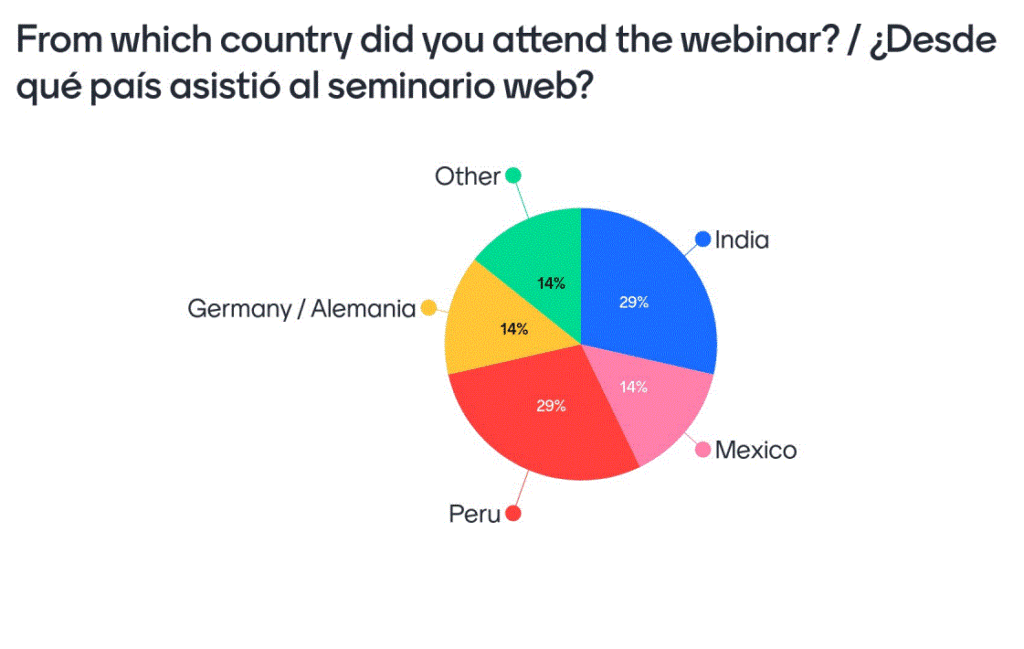
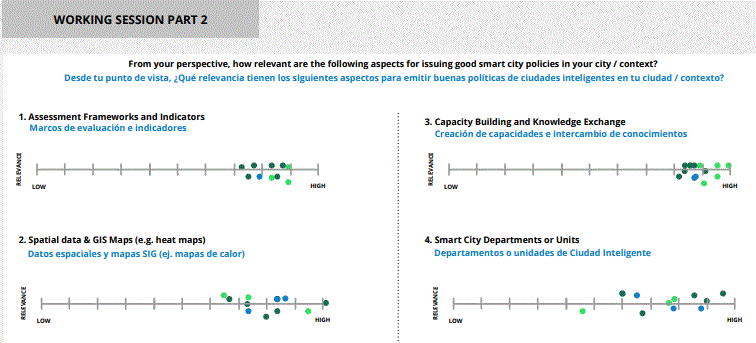
SMARTilience: Urban Governance Toolbox
The third topic was introduced by Rebecca Nell, researcher on Urban Governance from the University of Stuttgart. She presented the SMARTilience project which similarly to the ClimateSmart Cities Assessment framework aims at joining governance and resilience via the integration of climate resilience and climate protection into policy making. An important aspect resides in overcoming structural hurdles in municipalities and to foster collaboration to encourage thinking outside the box.

In the project’s real-world laboratories in the German cities Mannheim and Halle specific challenges are analyzed and user-oriented data utilization strategies are developed. Exchange between the cities as well as scientific and economic actors is enabled by peer-to-peer learning and technical support consists in the urban governance toolbox which provides solutions in the form of use cases based on individually selectable scenarios. The toolbox contains over 150 tools for analyzing data on specific climate-induced challenges and will be released this year for open use. At this point the significance of adequate control approaches becomes apparent to enable municipalities to strategically address climate resilience and translate it into intergovernmental action plans.
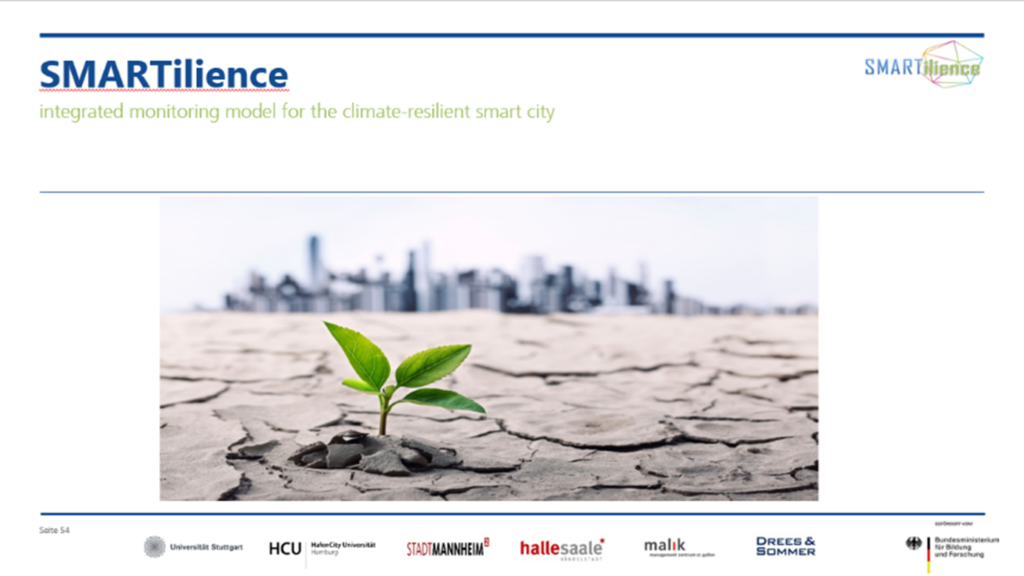
Digital City Unit Leipzig
The last segment of the webinar was headed by Nadja Riedel who is Senior Project Manager of the Digital City Unit of Leipzig and gave interesting insights into the way a municipality approaches and institutionalizes the smart city topic. She started by introducing the city of Leipzig, which after an intense decrease in population after the fall of the Berlin wall, has become one of the fastest growing cities of Germany in recent years. The challenges attached to this development are interdependent and require holistic solutions for traffic, housing and space.

Echoing the aforementioned need for cities to employ clever and wise strategies in terms of long-term urban planning which integrates social and environmental factors, the city of Leipzig follows the Integrated Urban Development Concept (INSEK) 2030. Nadja Riedel addressed again the problematic nature of municipal structures inhibiting cross-sectoral collaboration on strategies and solutions.
Via the EU-funded TRIANGULUM project the city had the opportunity to learn from strategies of other cities and subsequently founded the Digital City Unit in 2019, which is following a Smart City policy approach. As an intermediate actor within the city the unit facilitates cross-departmental networking as well as collaboration with research and business as well parties from outside the city. Importantly, a main focus is including civil society in urban transformation processes. Currently, the unit is working on various topics and projects for example developing an urban data platform, a citizen app “LeipzigApp” and concepts for networks and sensors in the energy and mobility sectors.
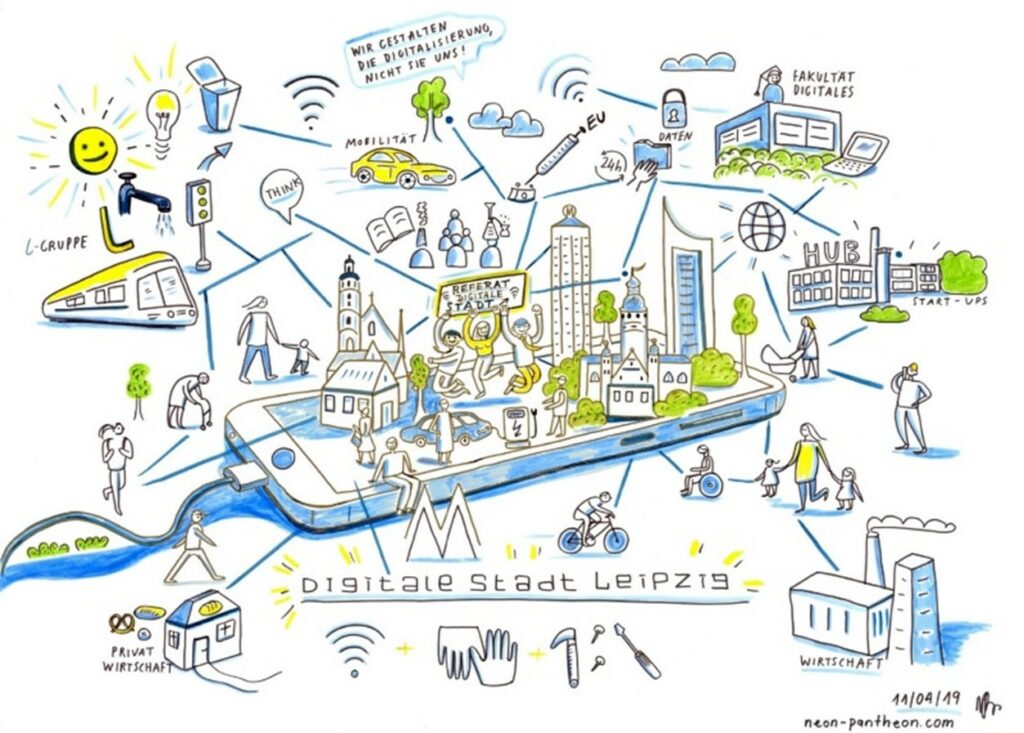
In conclusion it can be said that Smart City Policies play a prominent role for increasing the availability of knowledge and information on sustainable and environmentally conscious development as well as opportunity for citizen participation and enhancement of local business opportunities. The presentations showed that the nature of their implementation is key for not only making cities smart, but also clever and wise, meaning inclusive of social and environmental factors on a long-term basis.

